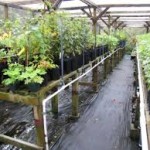 In recent years, best management practice (BMP) guidelines and corresponding regulations have focused heavily on container nurseries. Using the right nursery equipment as well as implementing BMPs can actually help nurseries save money by reducing costs. In some cases, nurseries that implement BMPs can receive state assistance to defray costs. Here is a look at a few of BMPs that can reduce costs.
In recent years, best management practice (BMP) guidelines and corresponding regulations have focused heavily on container nurseries. Using the right nursery equipment as well as implementing BMPs can actually help nurseries save money by reducing costs. In some cases, nurseries that implement BMPs can receive state assistance to defray costs. Here is a look at a few of BMPs that can reduce costs.
Sighting
Choosing a proper location can mean the difference between simple waste-water management and a financial nightmare. In the Tahoe region of California, for instance, nurseries must be at least 100 feet from streams and have a land grade of less than 5%[1]. Though exact sighting regulations vary from state to state and are influenced by federal law, it is important to know them so as to ensure that a nursery isn’t subject to additional financial obligations for installations like retention ponds, filtration systems, etc.
Waste Reduction
Waste is a major problem not just for landfills and waterways, but also for a nursery’s profit margin. Waste has a purchase cost, disposal cost, and a time cost (labor for management) associated with it. The last of the three costs in the so substantial that reducing waste can significantly impact labor costs.
BMPs for waste reduction are, in general, no different for nurseries than for households and many other industries. Reduce unnecessary purchases and buy materials that, if they can’t be reused, can either be recycled or composted. A container steamer, for instance, can clean and sanitize used containers. It has a return on investment (ROI) time of one to four years depending on the size of the nursery. A steam generator for treating potting soil for reuse has an ROI of less than one year in most cases[2].
Reduce Fertilizer
Reducing fertilizer use is a great way not just to reduce costs, but to reduce environmental impact as well. BMPs help nurseries to get the most out of the fertilizer they use, thus reducing waste and costs. Common BMPs for fertilizer include
- Testing substrate for pH/nutrient content,
- Supplying fertilizer at the right time and in the right amounts for individual crops,
- Ensuring fertilizer is applied to root zones only,
- Using cover crops to improve soil, and
- Installing water reuse systems[3].
Improving the Bottom Line
There are a number of BMP guidelines put out by both government bodies and non-governmental organizations interested in helping nurseries reduce environmental impacts. These BMPs, however, can also help nurseries to save money by reducing waste and by reducing pest/pathogen burdens. Soil and water conservation entities from state and local governments are always willing to help with assessments.
Resources
[1] “Nursery Facility Management.” [Online]. Available: http://www.tahoebmp.org/Documents/BMPHandbook/Chapter%204/4.2/o_NurFacMng.pdf. [Accessed: 15-Sep-2015].
[2] “Best Management Practices-Waste Reduction – best-management-practices-waste-reduction.pdf.” [Online]. Available: http://www.climatefriendlynurseries.org/resources/best-management-practices-waste-reduction.pdf. [Accessed: 15-Sep-2015].
[3] “Best Management Practices-Nutrient Efficiency – best-management-practices-nutrient-efficiency.pdf.” [Online]. Available: http://www.climatefriendlynurseries.org/resources/best-management-practices-nutrient-efficiency.pdf. [Accessed: 15-Sep-2015].
[4] http://www.climatefriendlynurseries.org
[5] http://www.tahoebmp.org
[6] http://bmp.ifas.ufl.edu

